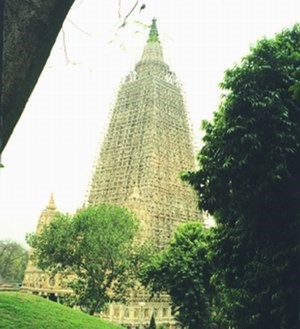Lumbini
Lumbini is situated at the foothill of the Himalayas in northern Nepal. This is the birthplace of Buddha. It was a custom that women would go to their parents’ home to give birth. The Buddha’s mother queen Maya was on her way to her family home. As she came to Lumbini she was spellbound by the park’s natural beauty. While resting, she gave birth to Siddhartha Gautama; the future Buddha. It was between the 5th and 4th century BC.
About some 200 years after the Buddha passed away, king Asoka visited Lumbini and constructed a stone pillar, which bears an inscription of Buddha’s birth. However Lumbini was neglected for centuries until the 19th century, excavation of the site revealed the existence of a temple and one of the sculpture sandstone depicted the scenes of the Buddha’s birth.
Bodh Gaya

Bodh Gaya is where the Buddha attained enlightenment. After six years of ascetic practice, Siddhartha still could not find a way out of suffering. As he walked to the river to wash himself, he was so weak that he collapsed on the bank of the river. A shepherd girl, Sijata was passing by and offered him a bowl of milk, which he drank in one gulp. As his physical strength was slowly restored, Siddhartha realised that neither tormenting the physical body nor indulgence in sensual pleasure can lead to realisation. When he went to Bodh Gaya, he decided to remain there.
He gathered some straw and made it into a seat under a paya tree. He made a vow that unless he attained enlightenment he would not raise from his seat. It was a real battle between good and evil. The evil king, Mara attacked him with all thoughts of temptation, greed, desire and fear, but Siddhartha was unmoved. After seven days, Siddhartha reached enlightenment. He broke through the chain of illusion. He’s awakened to the truth and from then on he was known as Buddha. He worked out the twelve links of dependent origination that explains our coming into this world and the possible outcome for the future.
The tree that Buddha sat under for enlightenment is known as Bodhi tree, Bodhi means seed of awakening. It was known from legend that the original Bodhi tree had been chopped down by Asoka’s wife who was jealous of her husband spending so much at the site. A new tree grew from the original tree and this is the present tree that we see today in Bodh Gaya. However, a branch from the original Bodhi tree was cut down and brought to Sri Lanka in the 3rd century BC by bhukkhni Sangamitta, daughter of Asoka’s. This tree remains in Mahavihara monastery to this very day.
Sarnath
After enlightenment at Bodh Gaya, the Buddha went to Sarnath situated on the outskirt of Veranasi. It is here that he first turned the wheel of Dharma in motion for five ascetics and explained to them the Middle Path, the Four Noble Truths and the Eightfold Paths. Thus began the first Buddhist order. A monastic tradition flourished for over 1500 years at Deer Park. In the 3rd century BC King Asoka built a pillar 15m high with 4 lions at the top. The lions symbolise Asoka’s imperial rule and the kingship of the Buddha. Today, the 4-lion is adopted as India’s national emblem.
Kusinara
The last sacred site, where the Buddha passed away is Kusinara. As Buddha approached the village of Kusinara, he became very ill. The Buddha was approaching eighty. He told Ananda to prepare a bed for him.
With his disciples gathered around him, the Buddha asked his disciples to pose any questions they may have. The Buddha repeated this three times but still they remained in silence. The Buddha then said to them, “everything once born is subject to decay. It’s the law of nature, follow the precepts, let it be your teacher…?Soon afterwards, the Buddha entered paranirvana (the great passing away). It was on the full moon of April and the year was around 487 and 483 BC. Mahakasyapa performed the final ceremony on the seventh day by cremating the Buddha. After cremation, the ashes were collected as relics which were divided into eight parts shared by eight kingdoms which ruled ancient northern India. The relics were again subdivided after king Asoka built 84,000 stupas to house all these relics. Today these relics are enshrined in temples and stupas across Asia and now in some of our western countries.
Currently there is the Maitreya project, which is to build the world’s largest statue at Bodh Gaya in Bihar. This statue is a 152m tall, 50-story-high bronze statue of the Maitreya Buddha. The Maitreya Buddha is a representation of the future Buddha. Maitreya derives from Sanskirt maitri meaning compassion and universal love. The statue is estimated at a cost of 150 million US Dollars, designed to last for at least 1000 years.
(Source: FGS Nan Tien temple’s webpage “Four Pilgrimage Sites of Buddhism”.)
